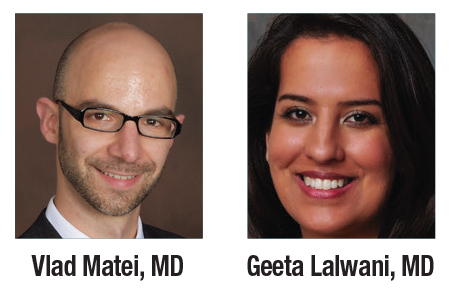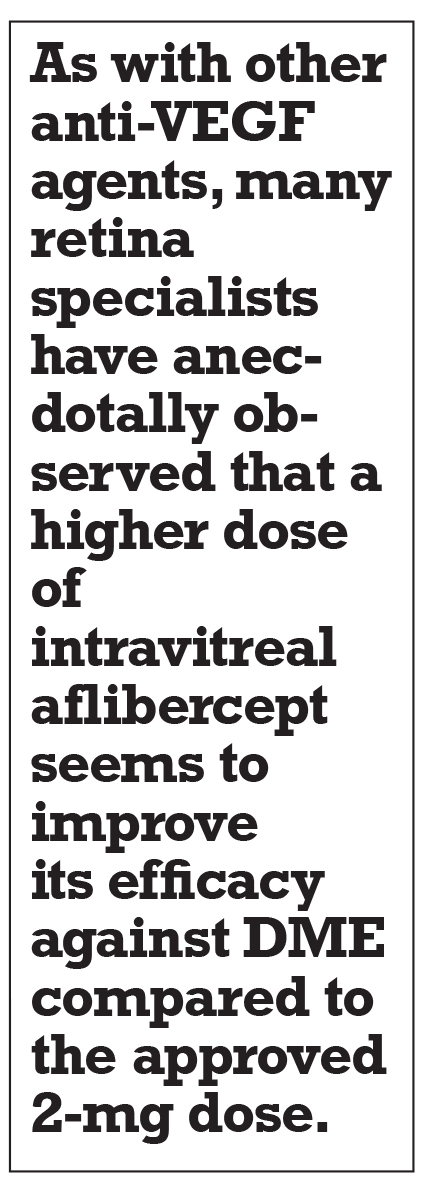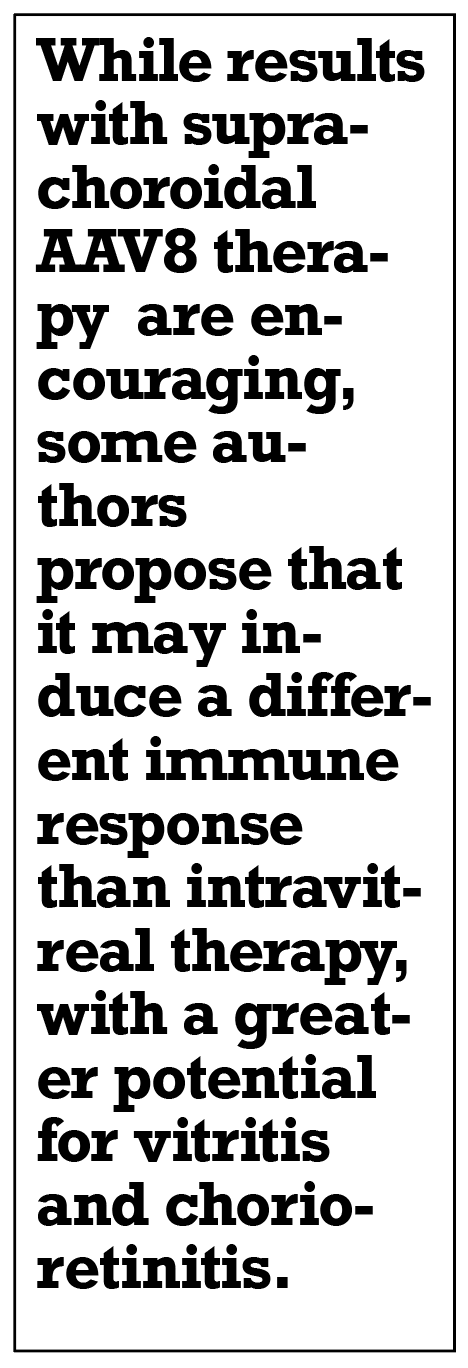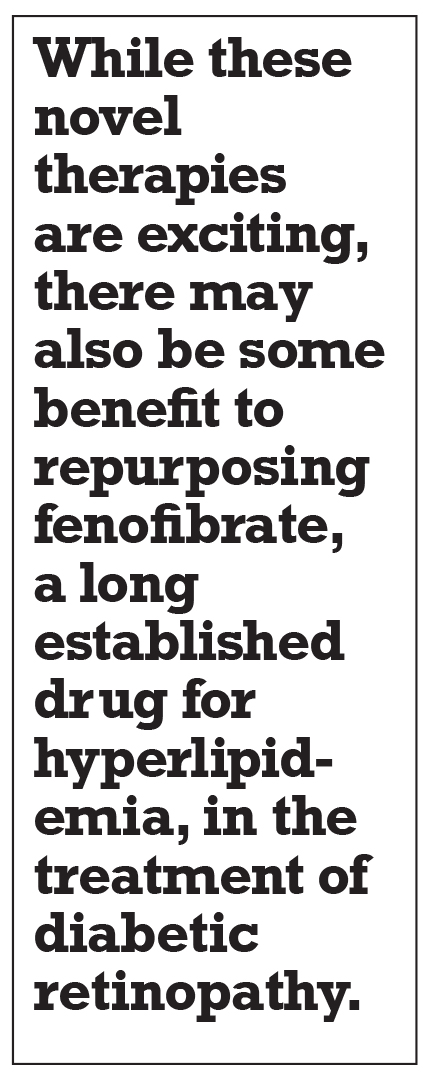| New Insights in Imaging |
Take-home points
|
 |
|
Bios Dr. Lalwani is a vitreoretinal surgeon and founder and president of Rocky Mountain Retina Associates. DISCLOSURES: Dr. Matei is a consultant to Carl Zeiss Meditec. Dr. Lalwani is a consultant to Carl Zeiss Meditec, |
The relentlessly increasing worldwide burden of diabetic retinopathy continues to fuel strong interest in improving the efficacy and durability of therapy. Beginning in the 1970s, for about 30 years laser photocoagulation was the only therapy for DR. Subsequently, intravitreal steroids were the only pharmacological treatment until intravitreal anti-VEGF agents became widely available.
Anti-VEGF agents were a game-changer and they’ve been the mainstay of DR/diabetic macular edema treatment for about 15 years. Various types of molecules with different vascular endothelial growth factor isomer affinities have been developed in this time. The recent approval of intravitreal faricimab, an inhibitor of both vascular endothelial growth factor A and angiopoietin-2, was a milestone in the mechanism of action of commercially available DR therapeutics. In light of the hastening pace of DR therapy evolution, we provide an update on emerging therapies for DR.
When considering upcoming treatments, it’s helpful to first recognize some of the basic strategies for expanding the repertoire of pharmacologic treatment. Besides targeting various molecular pathways, options include repurposed therapies effective for other diseases, different doses or combinations of existing treatments, alternative pharmacologic vehicles and alternative routes of delivery. In addition, new surgical technologies and techniques can also be developed. DR therapy is evolving on nearly all of these fronts.
Evolution of anti-VEGF therapies
Ranibizumab, the monoclonal antibody fragment that binds to all isomers of VEGF-A, has more recently been incorporated into a sustained-delivery device, surgically implanted through the sclera, for long-term intravitreal drug delivery. This Port Delivery System, or Susvimo (Genentech/Roche), is refillable in the clinic. On the heels of its approval for neovascular age-related macular degeneration, the Phase III Pagoda and Pavilion trials are evaluating its use for DME and DR, respectively.1,2 These trials are comparing monthly ranibizumab with PDS refilled every 24 weeks after a monthly loading-dose regimen. The primary endpoint is best-corrected visual acuity. Results are expected in October.
Aflibercept binds to all isomers of VEGF-A as well as VEGF-B and placental growth factor. In the wake of the VIVID, VISTA and DRCR Retina Network Protocol T trials,3,4 it remains a mainstay of DR therapy. As with other anti-VEGF agents, many retina specialists have anecdotally observed that a higher dose of intravitreal aflibercept seems to improve its efficacy against DME compared to the Food and Drug Administration-approved 2-mg dose. The Phase II/III PHOTON trial in DME is comparing 8-mg aflibercept injections q12 or q16 weeks (each in separate arms) with 2-mg injections q8 weeks. The primary outcome is BCVA change at 48 weeks.5
 |
Biosimilars emerge
While ranibizumab and aflibercept are very effective for treating DR, one ongoing drawback is their high costs. The U.S. patent for ranibizumab expired in 2020, while aflibercept’s will expire in 2023.
As a result, several companies outside the United States have developed biosimilars for ranibizumab, which are intended to provide the same therapeutic benefit at reduced cost. Per the World Health Organization, biosimilars are biotechnical products comparable in quality and performance to already approved reference products. Unlike generic drugs, which are chemically synthesized according to a drug’s established formula, biosimilars are manufactured with living cells according to a reverse-engineered representation of the original drug.6 Hence, biosimilars may be more immunogenic; their inherent deviation from the original synthetic process may lead to variations in quality.
Since the approval last year of the ranibizumab biosimilar SB11, now known as Byooviz (Samsung Bioepis) for nAMD, macular edema due to retinal vein occlusion and myopic choroidal neovascularization, we expect to see FDA-approved biosimilars for DR in the near future. A number of other biosimilars for nAMD are in development, and one biosimilar developer, Celltrion Healthcare, has initiated a trial of CT-P42, an aflibercept biosimilar, in DME.7
Gene therapy
This has been a very active area for investigative treatment to treat exudative disease, as the following programs illustrate.
• ADVM-022. Using gene therapy to potentially increase the durability of intravitreally administered anti-VEGF agents, ADVM-022 (Adverum Biotechnologies) is an adeno-associated virus vector capsid (AAV.7m8) carrying an aflibercept coding sequence controlled by an expression cassette. It’s designed to be delivered as a one-time intravitreal injection.
INFINITY is a Phase II trial evaluating the safety and efficacy of ADVM-022 for DME, in which patients received a single intravitreal injection of aflibercept 2 mg on day one, followed an ADVM-022 injection one week later. They were also prophylactically treated with topical difluprednate for 10 weeks.8 There were 12, 13 and nine patients in high-dose ADVM-022, low-dose ADVM-022, and control (serial aflibercept injections only) arms, respectively. The 24-week primary endpoint was time to worsening of DME activity (that is, time to requiring a supplemental aflibercept injection). By 24 weeks, only 25 percent of the high-dose and 39 percent of the low-dose groups required any supplemental aflibercept.
However, unfortunately, more than 80 percent of the low-dose and 90 percent of the high-dose patients had intraocular inflammation, including around 10 percent of whom had posterior IOI—although none had vasculitis. More than half of the patients treated with ADVM-022 had iris-related events, including transillumination defects and synechiae, and a quarter of high-dose patients had hypotony.9 INFINITY is expected to conclude by year-end.
• RGX-314. Representing innovations in both gene therapy and alternative routes of drug delivery, RGX-314 (RegenxBio) is an AAV8 vector encoding an anti-VEGF monoclonal antibody fragment that is being studied for subretinal or suprachoroidal delivery. Based on Phase I and II results in nAMD, the Phase II ALTITUDE trial is evaluating RGX-314 on the Diabetic Retinopathy Severity Scale at 48 weeks in patients with nonproliferative DR or mild proliferative DR without center-involved DME.10
The trial, expected to be completed in early 2023, is evaluating two doses of RGX-314 delivered suprachoroidally using the RegenxBio Suprachoroidal Space (SCS) Microinjector, which could be employed for in-office injections. Results from the first cohort of 15 patients getting the lower dose of RGX-314, compared to five controls, suggest good tolerability of RGX-314, with a few reports of conjunctival hyperemia or hemorrhage. One patient developing mild episcleritis; none developed IOI.11 Treated patients demonstrated stable BCVA and one-third had at least a two-step improvement in DRSS.
While these results are encouraging, some authors propose that suprachoroidal AAV8 may induce a different immune response than intravitreal therapy, with a greater potential for vitritis and chorioretinitis.12
 |
• Other gene candidates. Several additional molecular pathways relevant to DR are being studied, but few of the corresponding drugs have reached or shown positive results at the Phase II stage. OPT-302 (Opthea) is an intravitreally injected anti-VEGF R3 receptor fusion protein that acts as a “trap” molecule to block VEGF-C and VEGF-D. A Phase IIa trial evaluated a combination of OPT-302 and aflibercept in patients with persistent CI-DME following aflibercept monotherapy. At 12 weeks, patients in the combination therapy group gained a mean of 6.6 letters in BCVA vs. a mean of 3.4 letters in patients receiving a combination of sham with aflibercept.13
Fenofibrate
While these novel therapies are exciting, there may also be some benefit to repurposing fenofibrate, an established drug for hyperlipidemia, in the treatment of DR. Several studies have proposed that fenofibrate may slow the progression of DR, including by such mechanisms as reducing blood-retina-barrier breakdown.
Most recently in a multicenter cohort study based on a claims database, 5,835 NPDR patients without DME who were taking fenofibrate were found to have a lower incidence of PDR or a composite endpoint of PDR and DME (but not DME alone), when compared with 144,417 NPDR patients who were not taking the drug.14
On the basis of this and other hypothesis-generating studies, the DRCR Retina Network is recruiting for a trial comparing fenofibrate and placebo in the prevention of DR worsening over a four-year follow-up in patients with mild to moderately severe NPDR and no CI-DME at baseline.15
Nonpharmacologic treatments
Unfortunately, the pipeline of nonpharmacologic treatments for DME hasn’t been as fruitful. Photobiomodulation, the irradiation of tissue by far-red to near-infrared light (630-900 nm), demonstrated favorable effects in animal and in-vitro studies, including reduced apoptosis, oxidative stress, leukostasis and expression of pro-inflammatory molecules upregulated in DR. DRCR Protocol AE was a Phase II trial of diabetic adults with CI-DME, visual acuity >20/25 and no or minimal prior DME treatment, and compared the effect of PBM to that of an identical-appearing placebo device after four months of follow-up.16
 |
Despite a high study completion rate and no adverse effects among the 69 patients in each of the treatment and placebo arms, PBM did not demonstrate any significant effect on CI-DME compared with placebo. Based on this outcome, DRCR decided not to pursue a Phase III trial. Laser photocoagulation and pars plana vitrectomy remain the only validated surgical options for DR.
Early treatment
Perhaps the most impactful therapy may be disease prevention. Detecting and treating DR at an earlier stage leads to better visual outcomes. Because of the overwhelming number of diabetic patients compared to providers, teleretinal screening has become essential in detecting DR, and artificial intelligence will continue to be a key technology in the evolution of teleretinal screening.
A multicenter, head-to-head, real-world retrospective study of more than 20,000 Veterans Affairs patients with type 2 diabetes compared seven different artificial intelligence algorithms to human graders for detecting DR in fundus photos. The human grader demonstrated 100 percent sensitivity for detecting moderate or worse NPDR, while three of the AI algorithms showed the same sensitivity.17 Increasingly, refined AI algorithms may compensate for both the interpretation errors and short supply of human graders, making teleretinal screening more effective and accessible.
Bottom line
We’ve covered several therapies on the horizon for DR, including alternate doses of familiar anti-VEGF agents and biosimilars. Stem cell transplantation is yet another exciting strategy with potential applications in DR, but at this time most of the studies in this arena relevant to DR are still in the basic-science research phase.18
Overall, DR treatments in the pipeline have the potential to improve upon the efficacy and durability of existing treatments, although it remains to be seen how these benefits will be offset by safety risks. RS
REFERENCES
1. ClinicalTrials.gov. Identifier: NCT04108156. This study will evaluate the efficacy, safety, and pharmacokinetics of the port delivery system with ranibizumab in participants with diabetic macular edema compared with intravitreal ranibizumab (Pagoda). Updated April 21, 2022. https://clinicaltrials.gov/ct2/show/NCT04108156?term=NCT04108156&draw=2&rank=1 Accessed March 24, 2022
2. ClinicalTrials.gov Identifier: NCT04503551. A multicenter, randomized study in participants with diabetic retinopathy without center-involved diabetic macular edema to evaluate the efficacy, safety, and pharmacokinetics of ranibizumab delivered via the port delivery system relative to the comparator arm (Pavilion). Updated February 17, 2022. https://clinicaltrials.gov/ct2/show/NCT04503551?term=NCT04503551&draw=2&rank=1 Accessed March 24, 2022.
3. Heier JS, Korobelnik J-F, Brown DM, et al. Intravitreal aflibercept for diabetic macular edema: 148-week results from the VISTA and VIVID studies. Ophthalmology 2016;123:2376-2385.
4. Wells JA, Glassman AR, Ayala AR, et al. Aflibercept, bevacizumab, or ranibizumab for diabetic macular edema: two-year results from a comparative effectiveness randomized clinical trial. Ophthalmology 2016;123:1351-1359.
5. ClinicalTrials.gov Identifier: NCT04429503. Study of a high-dose aflibercept in participants with diabetic eye disease (PHOTON). Updated September 2, 2021. https://clinicaltrials.gov/ct2/show/NCT04429503?term=NCT04429503&draw=2&rank=1 Accessed March 3, 2022.
6. Kapur M, Nirula S, Naik MP. Future of anti-VEGF: biosimilars and biobetters. Int J Retina Vitreous 2021;8:2.
7. ClinicalTrials.gov Identifier: NCT04739306. Study to compare efficacy and safety of CT-P42 in comparison with Eylea in patients with Diabetic Macular Edema. Updated August 2, 2021. https://clinicaltrials.gov/ct2/show/NCT04739306?term=NCT04739306&draw=2&rank=1 Accessed April 23, 2022.
8. ClinicalTrials.gov Identifier: NCT0441842. ADVM-022 intravitreal gene therapy for DME (INFINITY). Updated January 11, 2022. https://clinicaltrials.gov/ct2/show/NCT04418427?term=NCT04418427&draw=2&rank=1 Accessed April 22, 2022.
9. Boyer DS. Results from a Phase 2 study of ADVM-022 intravitreal gene therapy for diabetic macular edema: the INFINITY trial. Paper presented at the American Academy of Ophthalmology Retina 2021 Subspecialty Day; November 12, 2021; New Orleans, LA.
10. ClinicalTrials.gov Identifier: NCT04567550. RGX-314 gene therapy administered in the suprachoroidal space for participants with diabetic retinopathy without center-involved diabetic macular edema (ALTITUDE). Updated March 29, 2022. https://clinicaltrials.gov/ct2/show/NCT04567550?term=NCT04567550&draw=2&rank=1Accessed April 22, 2022
11. Avery RL. Two-year results from the subretinal RGX-314 gene therapy phase 1/2a study for the treatment of nAMD and an update on suprachoroidal trials. Paper presented at the American Academy of Ophthalmology Retina 2021 Subspecialty Day; November 12, 2021; New Orleans, LA.
12. Chung SH, Mollhoff IN, Mishra A, et al. Host immune responses after suprachoroidal delivery of AAV8 in nonhuman primate eyes. Hum Gene Ther 2021;32:682-693.
13. Opthea. Phase 1B/2A DME Clinical Trial: OPT-302-1003 (COMPLETED). https://opthea.com/dme-clinical-trial/ Accessed March 3, 2022.
14. Meer E, Bavinger JC, Yu Y, et al. Association of fenofibrate use and the risk of progression to vision-threatening diabetic retinopathy. JAMA Ophtalmol. Published online April 7, 2022. doi: 10.1001/jamaophthalmol.2022.0633.
15. ClinicalTrials.gov Identifier: NCT04661358. Fenofibrate for prevention of diabetic retinopathy worsening (Protocol AF). Updated January 27, 2022. https://clinicaltrials.gov/ct2/show/NCT04661358?term=NCT04661358&draw=2&rank=1 Accessed April 18, 2022.
16. Kim JE, Glassman AR, Josic K, et al. A randomized trial of photobiomodulation therapy for center-involved diabetic macular edema with good visual acuity (Protocol AE). Ophthalmol Retina. 2022;6:298-307.
17. Lee AY, Yanagihara RT, Lee CS, et al. Multicenter, head-to-head, real-world validation study of seven automated artificial intelligence diabetic retinopathy screening systems. Diabetes Care. 2021;44:1168-1175.
18. Li X-J, Li C-Y, Bai D, et al. Insights into stem cell therapy for diabetic retinopathy: A bibliometric and visual analysis. Neural Regen Res. 2021;16:172-178.



